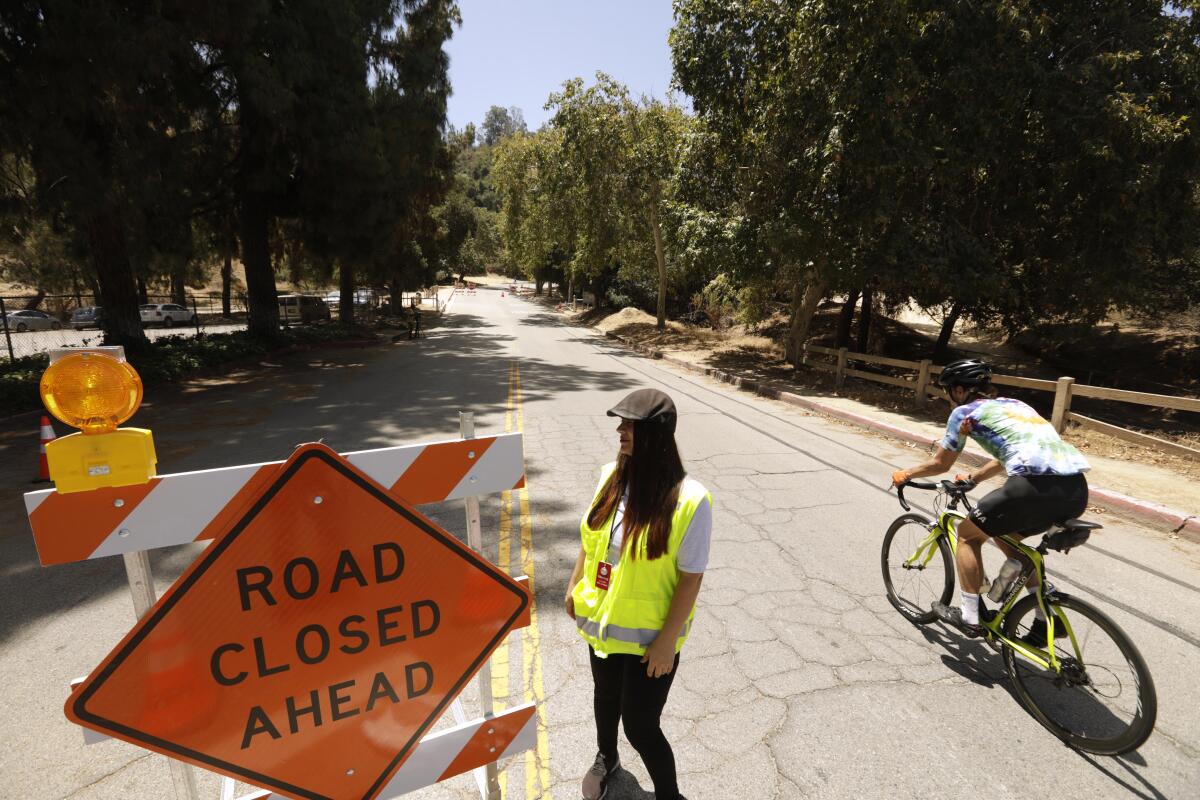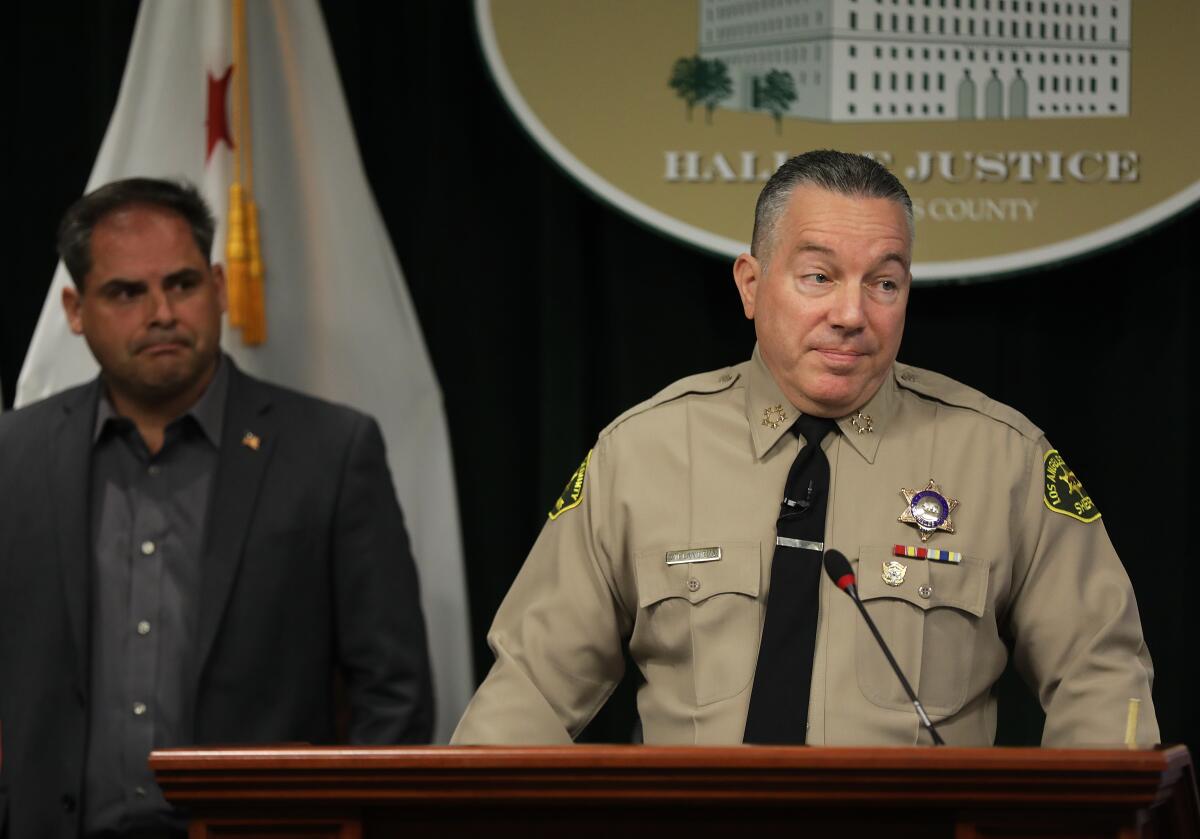A new road revolution: Banning cars from streets

- Share via
Good morning, and welcome to the Essential California newsletter. It’s Friday, July 8. I’m Metro reporter Alejandra Reyes-Velarde, writing from Long Beach.
Mid-pandemic, I, like a lot of people, picked up a series of short-lived pandemic hobbies. One of those was biking through my neighborhood in Long Beach.
For a time, the city closed a portion of a street near my neighborhood to vehicle traffic, leaving it open for residents to walk, run or bike freely. I took advantage.
Not having to nervously look over my shoulder while riding my bike made for a more relaxing experience, encouraging me to pursue this hobby for a little longer than I might have otherwise. I liked using that road as long as I could, stretching out the length of time I knew I would feel safe, before turning to bike toward the ocean.
Eventually, the street opened back up to cars. I haven’t been on my bike since.
But the short trend across L.A. County seems to have inspired a movement to close off more roads, maybe permanently, for runners, hikers, equestrians and cyclists to enjoy. My colleague Jonah Valdez writes that the city has closed a stretch of Griffith Park Drive, which cuts through the heart of the park, until July 18 as part of a pilot program.
The movement caught momentum after the death of cyclist Andrew Jelmert, who was struck from behind by a car during a training ride through Griffith Park in April. Reclaiming public roadways for bicyclists and pedestrians is a major effort, especially in a city known for its car culture and where traffic deaths caused by cars are increasing.

Cyclists in L.A. report sentiments similar to what I felt while on my pandemic bike rides. During stressful times, being able to safely ride a bike offered moments of much-needed tranquility.
Drew Valenti, who also picked up cycling during the pandemic, told Jonah that he felt safer riding Griffith Park Drive with no cars to worry about.
“And the result of it feeling safer, it was a more productive ride,” he said. “You’re able to sort of be in a more meditative state. And I think that’s a good thing for a public park to be able to do for us.”
Los Angeles follows other major cities, including New York and San Francisco, with similar programs.
[Read the story: “L.A. just banned cars from a major Griffith Park road. Is it beginning of road revolution?”]
And now, here’s what’s happening across California:
Note: Some of the sites we link to may limit the number of stories you can access without subscribing.
L.A. STORIES
This L.A. rapper sang about stealing unemployment funds in a song. Now, he’s pleading guilty to fraud. Nuke Bizzle implied in his music video titled “EDD” that he was “going to the bank with a stack of these,” holding up envelopes presumably from the California Employment Development Department. According to a plea agreement, the rapper, whose real name is Fontrell Antonio Baines, 33, used a series of stolen identities to fund his lifestyle in the Hollywood Hills from July 2020 to September 2020. He agreed to plead guilty to charges that he ripped off more than $1.2 million in Pandemic Unemployment Assistance. Los Angeles Times
Our daily news podcast
If you’re a fan of this newsletter, you’ll love our daily podcast “The Times,” hosted every weekday by columnist Gustavo Arellano, along with reporters from across our newsroom. Go beyond the headlines. Download and listen on our App, subscribe on Apple Podcasts and follow on Spotify.
POLITICS AND GOVERNMENT
L.A. County supervisors want the power to remove an elected sheriff from office. The Board of Supervisors is proposing a change to the county’s charter that would give it the authority to force out a sitting sheriff if four of five supervisors agree that the sheriff is unfit for office. The change would require voter approval in November’s general election. The move would fundamentally reshuffle the balance of power in the county and highlights how bitter and dysfunctional the relationship between Sheriff Alex Villanueva and county leaders has become. Los Angeles Times

Support our journalism
HEALTH AND THE ENVIRONMENT
The food industry is responsible for the most COVID violations but paid fewer fines. A new report revealed that food industry employers had four times as many citations for violating COVID-19 regulations — such as requiring masks and physical distances and notifying local and state agencies about COVID-19 outbreaks — compared with all other California industries combined. Yet the average citation was just over $20,000, a number that researchers said didn’t align with the severity of the violations. Fresno Bee
Got COVID? Doctors warn that powering through it can worsen the health toll. As vaccines and new treatments have eased some of the alarm around a COVID-19 diagnosis, continuing to work from home has become a familiar practice among professionals who can do their jobs remotely. Physicians caution, however, that rest is an important part of weathering a coronavirus infection. Plugging away from home is better than putting others at risk of getting infected, but it can strain the immune system, worsening the infection’s toll, experts say. Los Angeles Times
CALIFORNIA CULTURE
Young white people drove the mass San Francisco exodus. It’s common knowledge that urban dwellers are moving out of big cities such as San Francisco, which has enjoyed a population boom over the last decade. Now, new data reveal exactly who is leaving, giving a better picture of the city’s loss. According to U.S. Census Bureau data, white young adults in their 20s drove San Francisco’s historic population decline. San Francisco Chronicle
Free online games
Get our free daily crossword puzzle, sudoku, word search and arcade games in our new game center at latimes.com/games.
CALIFORNIA ALMANAC
Los Angeles: Sunny, 80. San Diego: Partly cloudy, 74. San Francisco: Sunny, 71. San Jose: Sunny, 81. Fresno: Sunny, 99. Sacramento: Sunny, 95.
AND FINALLY
Today’s California memory is from Sally Currie:
My first husband and I moved to California in 1956 after his graduation from Harvard Business School. We drove across the country in a used station wagon. My first camping experience was … somewhere in Sequoia National Park. We were too tenderfoot to realize that one has to put the head of a sleeping bag away from the wind if one does not have a tent, so we were chilly all night. This turned out to be a good thing because I was awake at 4 a.m. when I felt a nuzzling near my head and something pawing at my sleeping bag. Fortunately I had no food in the bag and the honey black bear … just walked on by. I remember letting out my breath and saying, ‘Uh-oh, Rig, the bear.’
If you have a memory or story about the Golden State, share it with us. (Please keep your story to 100 words.)
Please let us know what we can do to make this newsletter more useful to you. Send comments to essentialcalifornia@latimes.com.
Sign up for Essential California
The most important California stories and recommendations in your inbox every morning.
You may occasionally receive promotional content from the Los Angeles Times.







